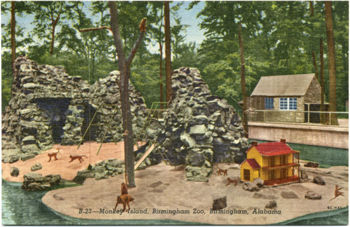Monkey Island: Difference between revisions
Jump to navigation
Jump to search
(New page: right|thumb|350px|Postcard view of Monkey Island '''Monkey Island''' was the first animal exhibit constructed for the Birmingham Zoo at [[Lane Park...) |
No edit summary |
||
| Line 3: | Line 3: | ||
Labor to construct the exhibit was donated by local unions and materials, such as slag for concrete aggregate, were donated by industries. The exhibit was built to resemble an island with rocky outcrops and was surrounded by a shallow pool of water. The interior of the structure is a heated room covered in glazed tiles that could be hosed down every evening. A tunnel connects the room to a building north of the exhibit. | Labor to construct the exhibit was donated by local unions and materials, such as slag for concrete aggregate, were donated by industries. The exhibit was built to resemble an island with rocky outcrops and was surrounded by a shallow pool of water. The interior of the structure is a heated room covered in glazed tiles that could be hosed down every evening. A tunnel connects the room to a building north of the exhibit. | ||
In later years the exhibit was reconfigured as a habitat for alligators and snapping turtles, and later for waterfowl. | |||
==References== | ==References== | ||
Revision as of 00:10, 10 January 2009
Monkey Island was the first animal exhibit constructed for the Birmingham Zoo at Lane Park. It opened on April 2, 1955 and was the brainchild of Mayor Jimmy Morgan.
Labor to construct the exhibit was donated by local unions and materials, such as slag for concrete aggregate, were donated by industries. The exhibit was built to resemble an island with rocky outcrops and was surrounded by a shallow pool of water. The interior of the structure is a heated room covered in glazed tiles that could be hosed down every evening. A tunnel connects the room to a building north of the exhibit.
In later years the exhibit was reconfigured as a habitat for alligators and snapping turtles, and later for waterfowl.
References
- Hogan, Ben (January 1969) "To 'Mr. Birmingham' the zoo is his trophy" Birmingham News
